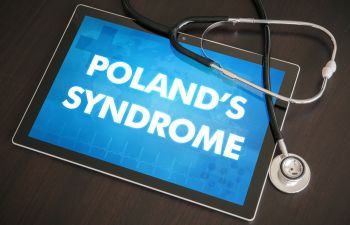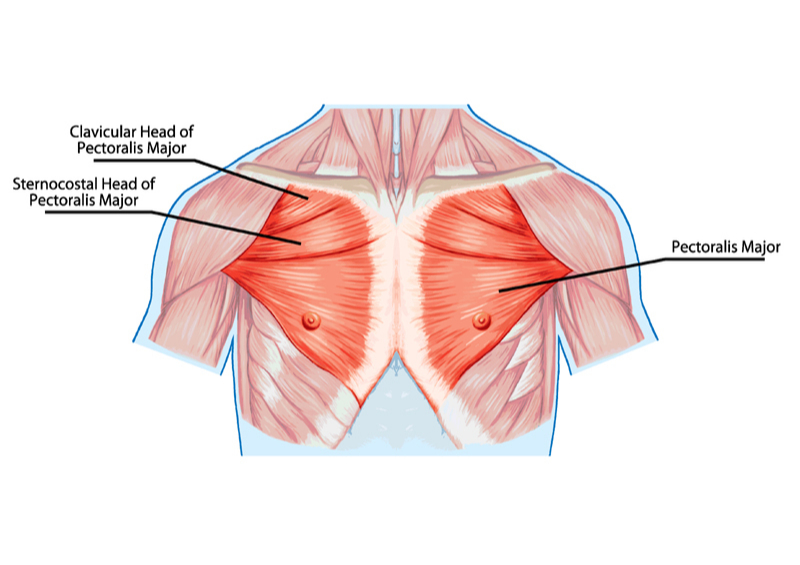Poland Syndrome: What Patients Should Know

Poland Syndrome, in which one pectoral muscle is absent, is a congenital birth defect of the chest wall that affects both women and men alike. Poland Syndrome can range from the subtle asymmetry of the chest to stark differences in appearance. While the impact of Poland Syndrome is primarily aesthetic, many people with Poland Syndrome seek out reconstructive treatment in order to achieve a more symmetrical appearance.
Is Poland Syndrome a rare disease?
Poland Syndrome is a rare condition. Many people struggle to obtain an official diagnosis with Poland Syndrome because it is such a rare disorder– it occurs in only 1 out of 100,000 births. It is not uncommon for patients to visit several doctors before they are diagnosed, or go many years without any diagnosis at all.

What does Poland syndrome look like?
While all patients with Poland Syndrome experience chest wall asymmetry, there are many other deformities that may– but do not always– appear. Some individuals also have asymmetrical arms, syndactyly, or a missing hand.
Treatment options to fix Poland Syndrome
While there is no single test to determine if you have Poland Syndrome, receiving a diagnosis can be as simple as a consultation with the right plastic surgeon. Dr. Azouz has years of experience in treating men and women with Poland Syndrome and is able to diagnose Poland syndrome through virtual or in-person appointments.

The primary complaint of most Poland Syndrome patients is with physical appearance. The chest wall is a central aspect of body image for both men and women, and achieving a more symmetrical look is beneficial both functionally and emotionally. Depending on body type and the severity of your asymmetry, plastic surgeon Dr. Azouz will recommend either a breast implant or fat tissue graft for treatment to achieve dramatic results without the need for potentially deforming muscle flaps and tissue expanders.
Dr. Azouz often uses a direct to implant approach to correct Poland Syndrome in men and women. Some patients are even able to achieve their desired results without an implant. Regardless of treatment options, surgery is typically done after puberty when the breasts have reached full development. In addition, some Poland patients have an asymmetrical or absent nipple on the affected side. Changing nipple size and shape via surgery or cosmetic tattooing can also give a more symmetrical look.
Do I need a fat graft?
Some people with Poland Syndrome are candidates for receiving a fat graft in addition to a breast implant. Fat grafting is an excellent way to add volume around the breast implant to make your chest look as natural as possible– in this procedure, fatty tissue is removed from one part of your body and placed in another. Fat grafting can be performed at the same time as your implant surgery and does not largely affect recovery time.
Life Post-Operatively
After receiving surgical treatment, Poland Syndrome patients often find a newfound sense of confidence and improved body image. With a more symmetrical chest, fitting into clothing items like gym shirts, bras is easier and more comfortable than before. Newfound confidence also allows many patients to feel comfortable wearing bikinis, changing in the locker room, and low-cut tops for the first time in their life. Compared to before surgery, patients often find they not only look different but they feel different too. For the first time, these patients are not limited by fears of embarrassment or being judged for their own bodies.
Contact Poland Syndrome Surgeons in Dallas
Board-certified plastic surgeons Dr. David Azouz and Dr. Solomon Azouz have extensive experience in treating Poland Syndrome patients in Dallas, Texas. Internationally renowned for his superior techniques, Dr. Azouz is here to help you get results often with outpatient surgery. Call or contact us online to get started today at (972) 702-8888 or by filling out our online form.
Posted on behalf of
